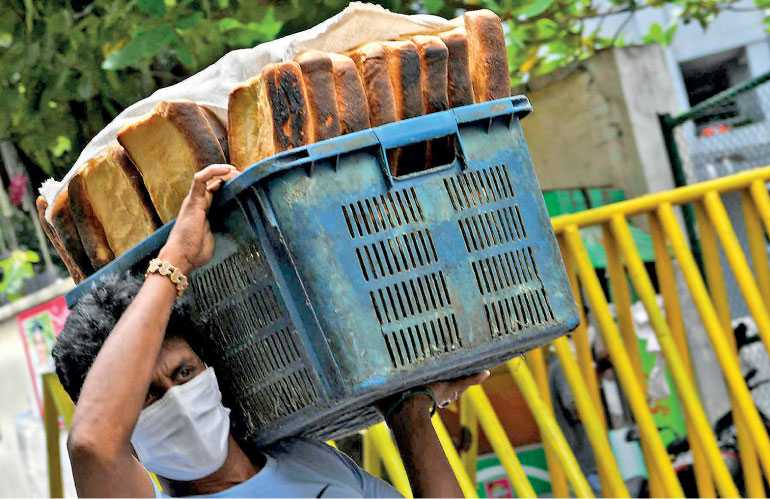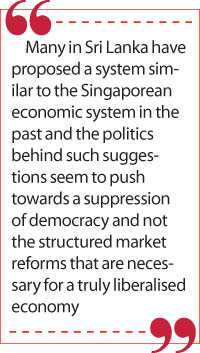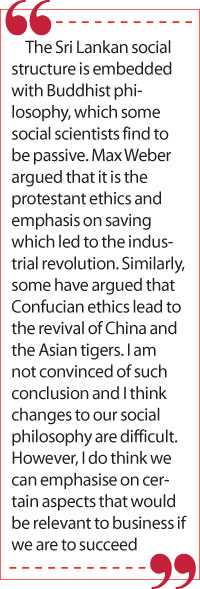Saturday Dec 14, 2024
Saturday Dec 14, 2024
Wednesday, 3 June 2020 00:00 - - {{hitsCtrl.values.hits}}

It is evident that the post COVID-19 context will pose unprecedented economic hardships and social challenges. In order to face them effectively, this is the best time to think about structural changes that are necessary – Pic by Shehan Gunasekara
With the chaos resulting from COVID-19, many have questioned the effectiveness of the neoliberal economic model. A debate about the negative impacts of the open economic system has been on going in Sri Lanka ever since the introduction of free market reforms in 1977. 
Although successive governments have experimented with economic liberalisation policies with varying degrees of openness, it is fair to say that we have neither experienced a fully open market economy nor have the opponents proposed a credible alternative, except suggestions on, what I would broadly categorise as, “efficiency increases”.
Many in Sri Lanka have proposed a system similar to the Singaporean economic system in the past and the politics behind such suggestions seem to push towards a suppression of democracy and not the structured market reforms that are necessary for a truly liberalised economy.
In a debate with Jordan Peterson, the popular communist, Slavoj Zizek suggests that a Chinese model would be most ideally suited to tackle today’s modern concerns. Virtues of a meritocracy based authoritarian government coupled with the dynamics of capitalism have seen the world’s most populous country achieve a tremendous economic growth during the last 30 years, unprecedented in recent human history.
Although there are glaring differences between the Chinese and the Singaporean, amongst them being Singapore’s inclination for more competitive elections and separation of power, it will be interesting to note, whether the commonalities of the Chinese and Singaporean models could be incorporated to overcome deficiencies of the Sri Lankan capitalist system.
Some deficiencies of Sri Lanka’s capitalist system are not unique to Sri Lanka. I have identified seven concerns.
FEATURES OF SRI LANKA’S CAPITALIST SYSTEM
1. Markets moving towards an oligopoly
Be it energy, pharmaceutical, investment banking, tobacco, telecommunication – world over, what we have been seeing is markets being dominated by oligopolies. Oligopolies do not function at an optimal market condition and give rise to a wide range of adverse outcomes. Furthermore, the influences of oligopolies are not restricted only to the realm of business. The fact that in 2016, only one Republican candidate among the US presidential nominees accepts the existence of climate change probably goes to show that decisions are little to do with science but more to do with influence of campaign finance.
Former United States Secretary of Labour and author of the book ‘Saving Capitalism,’ Robert Reich identifies that over 50% of the United States Congressmen are employed by corporate special interest groups upon their retirement. He points out the issue is not with lobbying but rather corporate lobbying, which since the 1980s has tipped the scale in favour of the corporates creating class of elite supercapitalist, which basically look after only their interest.
We have seen a similar footing in Sri Lanka particularly with the influence of private television companies on electoral processes. For example, one television company has been accused of strategically planting its employees as candidates of different political parties.
2. Income distribution 
World over and in Sri Lanka too, we have seen income disparities widening. Although economists such as Simon Kuznets try to show that this is an intermediary phenomena through Kuznet’s curve, Thomas Piketty through his study of 250 years of income distribution has shown that the rate of capital returns in developed countries are persistently greater than the rate of economic growth, which would imply widening income distributions.
Even if Kuznet’s curve is true, and as life takes a finite dimension, then the question which we will have to ask is how long we have to wait until we see market correction to the income distribution curve.
3. Creative capitalism vs. crony capitalism
This concept is exemplified in Daron Acemoglu and James A. Robinson’s book ‘Why Nations Fail: The Origins of Power, Prosperity, and Poverty,’ in which the authors compare Bill Gates with Carlos Slim, both of who had the distinction of being declared onetime as the richest men by Forbes . However, their achievement of such financial success seems to be based on different trajectories.
Gates is a pioneer in information technology, cofounded Microsoft, created a new industry and transformed how we work, live and interact. In doing so, he directly and indirectly created millions of jobs which resulted in an enhancement of the general wellbeing of the people. Slim, no doubt a brilliant entrepreneur is accused of bribing politicians, and made billions buying underperforming government assets at low prices.
In the Sri Lankan context, we see many businessmen resembling the Carlos Slim type and not Bill Gates type businessmen. The State should foster creative capitalism and not entertain the ‘robber barons’ as stated by former President J.R. Jayewardene in the early 1980s. It is said when Ratan Tata was asked why he wasn’t the richest person in the world unlike Mukesh Ambani, his response was that the Ambanis were businessmen, while he was an industrialist. What Sri Lanka needs right now are not people just making money but people starting industries and creating jobs and contributing to the real economy.
4. Top down vs. bottom up capitalism
Many make the fundamental mistake when speaking of capitalist models to categorise all models as the same. In Henry Heller’s book ‘Birth of Capitalism,’ he points out that capitalism rests upon cultural factors rather than natural or material laws. Furthermore, he identifies different countries having a different historical context which is embedded in its capitalist models. For example, the United States has a more bottom up buccaneering, entrepreneurial type of capitalism, whereas in Japan and Germany, it was actually the aristocratic families that involved themselves in industry.
Sri Lanka is not different. Elitism and old boys’ networks play a vital role in industry today. People who do not belong to such circles try to make connections with politicians to further their cause. The so-called ‘new rich’ in Sri Lanka do not attempt to break down the barriers that kept them from reaching that stratum, but rather reinforce new barriers once their inclusion has been cemented. Prof. Raj Somadeva interprets Sri Lanka’s modern society as neo feudalistic. I tend to agree with this view. Unless we transform these patterns the benefits of capitalism will be enjoyed by a privileged few.
5. Meritocracy vs. nepotism
Both the Singaporean and Chinese economic models incorporate meticulous processes of rewarding merit. As per an article published in the ‘Journey of Democracy’ titled ‘China and the Singapore Model’ by Stephan Otamann and Mark Thompson, President Xi’s Four-Pronged Comprehensive Strategy, listed below, is an attempt to bring the Chinese model closer to the Singaporean model, in keeping with the principles of good governance and meritocracy.
a. Comprehensively build a moderately prosperous society
b. Comprehensively deepen reforms
c. Comprehensively govern the nation according to law
d. Comprehensively strictly govern the party
We have also seen how some countries like Germany and Japan have transformed their historical feudalist nature by incorporating egalitarian principals and rewarding people on merit and performance. In Sri Lanka, nepotism and old boys’ networks have influence not only in politics but also in business, a factor which badly needs to change if we are to expect higher rates of return on capital and a wider distribution of the benefits of capitalism.
6. Sustainability
In 1968, American philosopher Garrett Hardin published an article named ‘Tragedy of the Commons,’ articulating an economic principle described by William Forster Lloyd 100 years earlier. This principle describes the problem which arises when individuals consume common resources and act independently in their own self-interest, thereby depleting the resources and harming the collective interest. 
The existential problems of today such as climate change and global warming can be better resolved with state intervention. China’s attempt to transform from being the world’s biggest polluter to a more environmentally friendly nation is due to its strict state intervention. China’s push towards renewable energy exemplifies this fact. Such a push cannot be imagined in the Western world until the cost of renewables become cheaper than the cost of fossil fuels.
7. Theoretical limitations
Benjamin Franklin once famously said that “democracy is two wolves and a lamb deciding what’s for lunch.” The majority is not always right and in intricate matters more often wrong than right. Economists such as Kenneth Arrows through his impossibility theorem have shown the flaws of ranked voting systems. Arrows shows that a clear order of preferences cannot be determined while adhering to mandatory principles of fair voting procedures. For instance, if A is preferred over B and B is preferred over C, in a democracy, it doesn’t necessarily mean that A is preferred over C.
Furthermore, as voters vote for a ‘package deal’ inherently unpopular policies can be incorporated with popular policies. For instance, in the 2010 Presidential Elections, both candidates incorporated the abolition of the executive presidency into their election manifestos. The two leading candidates polled over 98% of the votes casted. However this is not a reflection of the ground reality if voters are specifically asked on their preference of a presidential system.
I believe that many of these deficiencies can be mitigated by greater state involvement in the economy to direct it towards better economic and social outcomes; even though such a change would usually be difficult in the backdrop of the frequent policy changes characteristic of a democratic system. However, I believe that we have an exceptional opportunity at the moment as the extraordinary economic downturn means that there is a high likelihood of significant capital gains even if there is a reversal of policy even in a five-year period, covering the downside risk.
Therefore, this would be an opportune moment for the state to invest both in terms of either considering investment value over a five year period or as proposed in this article for a more long-term strategic purpose. I had expressed my ideas to the Prime Minister as the Minister of Finance in letter which can viewed at https://twitter.com/tharakabalasur1/status/1260127838251782145?s=12.
This article examines how a study of the Chinese and/or Singaporean models can inform such an approach and suggest changes that can be incorporated into long-term structural changes in the Sri Lankan economy.
PROPOSED REFORMS/WAY FORWARD
1. Meritocracy-based system
If a public/private partnership is to function at the most efficient level, particularly in the Sri Lankan context, the government ownership should be restricted to less than 50% of the shares. This is of primary importance as we have seen that with government holding more than 50% of a company, political interference will creep in.
We will be able to examine this fact more closely if we examine the case of SriLankan Airlines and the private sector banks in Sri Lanka. After SriLankan Airlines was reverted to the Government, questionable appointments were made to top posts by consecutive governments and consequently the company suffered. However, during the same period, the Sri Lankan Government undertook strategic holding in many of the private commercial banks through ETF/EPF, Sri Lanka Insurance and the State bank. This procedure not only prevented the collapse of Seylan Bank but also prevented oligarchs dominating the financial sector. A harmonious balance between the State and the private sector will also hinder corporate nepotism and act as a check against the influence of old boys networks.
2. Measured protectionism
After independence, Singapore continued its British model of using the advantage of Singapore’s location as an entrepôt and thus continued its policies with free market economic policies. In China, however, market reforms started with Deng Xiaoping and continue to use measured protectionist policies where needed. I believe that protectionism should only be viewed as a stop gap measure, until your infant industries reach maturity or in strategic sectors like agriculture.
More often than not, protectionism continues for extended periods of time thereby bringing in inefficiencies. Chinese industrial policies have succeeded not only because of protectionism but because there has been a state direction into areas where capital formation is needed. Economic historians will point out that both Germany and Japan did not rely primarily on private capital markets but government-driven accumulation of capital for investment. An example of this would be the Japanese Government’s attempt to foster the electronic sector after the Second World War.
In a context where even kites and Vesak lanterns are imported, large Government holding in Sri Lankan blue chip conglomerates can encourage them to invest in areas like consumer durables. If Damro has been successful in producing washing machines and televisions, more concrete efforts can lead to manufacturing in other areas. Sri Lanka imports around 75,000 three-wheelers a year. Keeping an eye on the future, most of these can be replaced by electric three-wheelers if the right direction and incentives are provided.
3. Overlaying social philosophy
Chinese society’s social fabric has been embodied with Confucian ethics for centuries. Although China under Mao tried to move away from the feudalistic nature of certain Confucian principals, according to Godfree Roberts, author of Why China leads the World, Mao himself was a Confucian in the same way as all Chinese are. Mao was a junzi (Confucian Gentleman) who aspired to be morally superior, intellectual, scholar, poet and an influential author. Since the 1990s Confucianism as an ideology has made a state supported comeback in China, perhaps as a counter narrative to growing western influence and materialism. Today, many numbers of schools have opened in China to teach youngsters and officials Confucian values.
Although Singapore promotes secularism and multiculturalism, business and politics of Singapore is dominated by the Chinese, who are influenced by Confucian principles. This was seen in 1991, when Singaporean Government introduced five principles called the shared value to all ethnic groups to forge a common, Singaporean identity towards the 21st century. The five values, Nation before community and society before self, Family as the basic unit of society, Community support and respect for the individual, Consensus not conflict, and Racial and religious harmony, are arguably very Confucian in nature.
Sri Lanka too needs to develop its ‘common values’. In order to do this, I believe, we would have to first break down the feudalistic traits and norms of our modern society. Thereafter, certain values have to be identified and pressed upon. President Gotabaya Rajapaksa’s presidential elections campaign, emphasised on a ‘vinaya-garuka samajak’ or a disciplined society. Similarly, perhaps a few more values which the Sri Lankan society seems to be lacking on and which all communities would agree upon, has to be identified and emphasised.
4. Both countries invest money in infrastructure and public goods
Singapore had a literacy rate of 68.9% in 1970. The fact that Singapore was able to raise its education system from these levels to the level of best primary education in the World demonstrates the monumental effort the Singaporean Government has put towards education. In a country where land is scarce and expensive, Singapore has allocated 14 acres for the National Institute of Education the sole teacher education institute in Singapore. China too has invested heavily in infrastructure development and public goods.
In a recent discussion between Kishore Mahbubani and Graham Allison on COVID-19 and the shifting global order, Mahbubani explains that, for thousands of years, the Chinese didn’t use the brains of 80 to 90% of their population. He states that only during the last 30 to 40 years, brains of 1.4 billion are being tapped into and they are being selected to a highly meritocratic based system where they get positioned at the correct places in line with their education. This is in stark contrast to a country like the United States, where the best brains, mathematicians and scientists end up being investment bankers.
Drawing from the comparative experience, Sri Lanka should not only make large investments in education, but also ensure that the correct people are in the correct positions in both Government and corporate sector. Sri Lanka continues producing the same talent in bulk with very limited alternative for the students who fail the mainstream hurdles. By picking the right talent for identified responsibilities and rewarding like in China, Sri Lanka can reduce one of our main issues when it comes to talent – migration.
In Sri Lanka, over 60% of the graduates are women, but a substantial portion of women, after childbirth, are at home due to gender based constraints. Social norms, unequal pay, unequal opportunity, sexual discrimination and a host of factors prevent Sri Lankan women reaching their full potential. In order to address these weaknesses structural changes and innovative methods will have to be incorporated to the Sri Lankan labour market.
5. Investments outside of its borders
Both countries invest extensively outside their national borders. It is estimated that Singapore’s GIC Private Holdings and Temasek Holdings, the two sovereign State funds of the Government, have assets over $ 700 billion. China is the world’s leading investor. Although, most of China’s Foreign Direct Investment (FDI) goes to developed nations, the majority of construction contracts go to developing countries. According to Heritage Foundation’s China Global Investment Tracker (CGIT), from 2005 to 2017, it is estimated that China spent $ 734 billion on construction projects alone across the globe. This has enabled China to not only bolster its economy but also to hold strategic investment with an aim of further global dominance.
Sri Lankan companies too have recorded attractive returns overseas. LOLC recently sold 70% of PRASAC, the largest micro finance company in Cambodia, to KB Financial Group of South Korea for $ 604 m. LOLC also owns 97% of the second largest microfinance company in Cambodia, LOLC Cambodia, which has assets over $ 1 billion. My argument, therefore, is not for the complete opening up of the capital account, but a more liberalised and structured attempt to identify and invest overseas.
Conclusion
It is evident that the post COVID-19 context will pose unprecedented economic hardships and social challenges. In order to face them effectively, this is the best time to think about structural changes that are necessary.
Some of the deficiencies of the capitalist model can be overcome by incorporating utilitarianism approach of the Chinese and the Singaporean models – society before self. The Government can buy cheap and invest heavily on blue chip companies (through purchase of primary shares), and thereafter encourage companies to collaborate and make strategic investments. I also advocate for Sri Lanka to find the right balance in the ownership so that the traditional Government sector inefficiencies will not creep in and private sector old boys’ networks and nepotism can be minimised.
The Government should encourage creative capitalism by setting up a private-public fund particularly to invest in technological start-ups. We are only at the beginning of the Fourth Industrial Revolution and such a move will no doubt position ourselves for greater returns in the future. As philosopher/historian Yuval Noah Harari says, we cannot envision the forthcoming technological advances. Harari expects, particularly with biotechnological developments, an evolutionary transformation of human beings will take place within the next 100 years.
The Sri Lankan social structure is embedded with Buddhist philosophy, which some social scientists find to be passive. Max Weber argued that it is the protestant ethics and emphasis on saving which led to the industrial revolution. Similarly, some have argued that Confucian ethics lead to the revival of China and the Asian tigers. I am not convinced of such conclusion and I think changes to our social philosophy are difficult. However, I do think we can emphasise on certain aspects that would be relevant to business if we are to succeed.
For example, Lord Buddha, in the Sigalovada Sutta said that individual’s wealth should be divided into four parts: One part for consumption, two parts for investments and fourth for future misfortunes. Although modern dynamics might not let us keep to those propositions, and with 23% of an employee’s salary being contributed to EPF and ETF, I think a social emphasis should be for more investment. Therefore the society’s risk taking propensity has to be improved by highlighting these concepts more powerfully.
I believe we can transform this country and make it more viable for business and economic growth. With the new President in office, we have a knowledgeable and a pragmatic leader who is committed to proper systems and processes. The purpose of this article is to initiate a broader dialogue and debate to identify our direction and to this effect, I hope it will find its purpose.
(The writer is a former MP.)